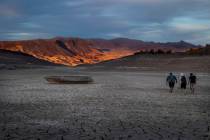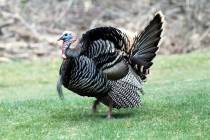Clean camps can limit bear encounters
Several hundred outdoor writers were milling around Tuesday morning in the hotel foyer at the Hotel Roanoke. Word spread quickly about Sunday night's fatal bear attack in the mountains southeast of Salt Lake City. It was the first fatal black bear attack documented in Utah.
At about 11 p.m., 11-year-old Samuel Ives of Utah Valley was in his sleeping bag when a bear tore through the tent, grabbed the boy and pulled him into the woods.
Ives' parents thought their son had been kidnapped, but law enforcement officials found bear tracks leading away from the tent. They followed the tracks for approximately 400 yards and found the boy's body.
Following a nine-hour search in rough country, Luke Osborne, a professional bear hunter, and his tracking dogs cornered the bear and Osborne killed it. Wildlife officers transported the bear's body to Utah State University in Logan. An animal autopsy was performed to confirm whether it was the same bear that had attacked Ives.
"A necropsy on the bear confirmed that this is the bear who attacked and killed this young boy," said Jim Karpowitz, director of the Utah Division of Wildlife Resources in a news release. "Our hearts and condolences go out to the young boy's family."
Wildlife officials throughout the western states have seen an increase in human-bear conflicts in recent years. This, officials have said on multiple occasions, is due in part to the ongoing drought but also to the seemingly endless growth in the region's human population.
That growth has put more people in bear country. Some go there to play, others to live. Either way, human-bear encounters will increase.
I don't know what led the bear to the Ives tent on Sunday night. Maybe the bear was attracted to the odor of food that might have been in the tent or on the boy.
Cedar and Beaver mountain are popular summer escapes for Southern Nevadans.
"We do have black bears on both Cedar and Beaver mountains,'' Bryce Chamberlain of the Utah DWR said. ''Bear encounters in this area are not common but also not what I would consider rare. Given the current water and food situation with the drought, bears will be moving in greater circles looking for food.
"Under these circumstances I think we can expect to have more human-bear encounters than on a normal year.''
Though bears have been and probably will be on the move, Chamberlain said, "If you keep a clean camp, you can do a lot to keep bears away. They really are not looking for people, just the scraps that we leave.
"Leaving food out, taking food or candy into your sleeping quarters, leaving garbage nearby your camp and even toothpaste near your tent are all bear attractants. Black bears have a highly developed sense of smell. Any of these things can draw them in from miles away."
Wildlife officials agree the following steps, if taken, will go a long way toward preventing a negative bear encounter.
• Never feed a bear.
• Keep campsites free of food and litter. Store food in bear-proof containers or hang it in a tree at least 100 feet from camp. Never store food in a tent where people will be sleeping.
• Prepare food away from the sleeping area.
• Remove all garbage from the area.
• Clean barbecue grills and cook stoves.
• Should you encounter a bear, give it plenty of room to pass. If a bear approaches you, do not run. This could trigger the bear's predator instinct, and you might become the prey. Do what you can to make yourself look bigger than you are. Wave your arms, spread your jacket open and yell loudly. Let him know you don't want him around.
• If the unthinkable happens and a black bear attacks, fight with every ounce of strength you have. At that point it has only one thing in mind: to eat you.
Think you're fast? Forget it. You cannot outrun a black bear. I've seen them run.
Doug Nielsen is a conservation educator for the Nevada Department of Wildlife and an award-winning freelance writer. He can be reached at doug@takinitoutside.com.
C. DOUGLAS NIELSENMORE
COLUMNS

















